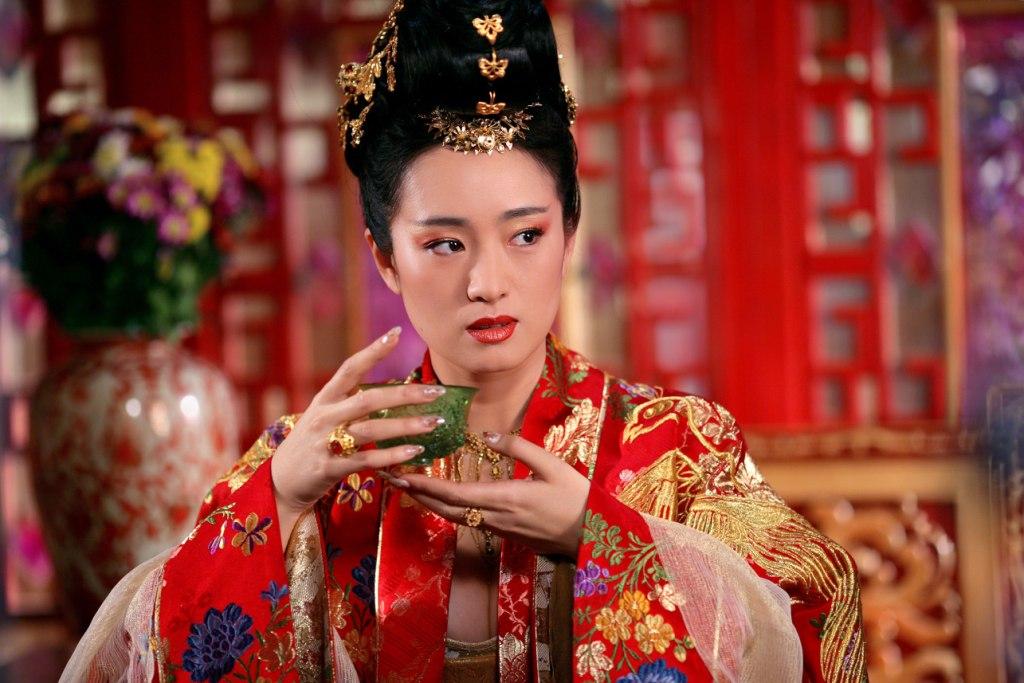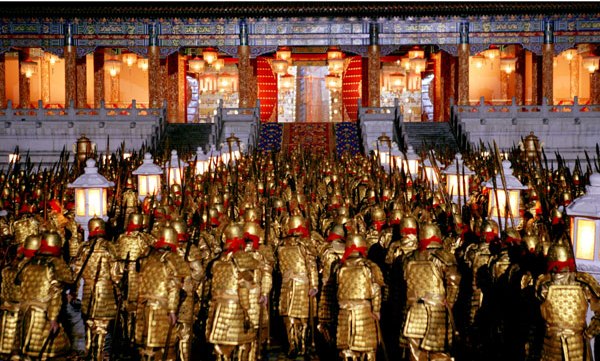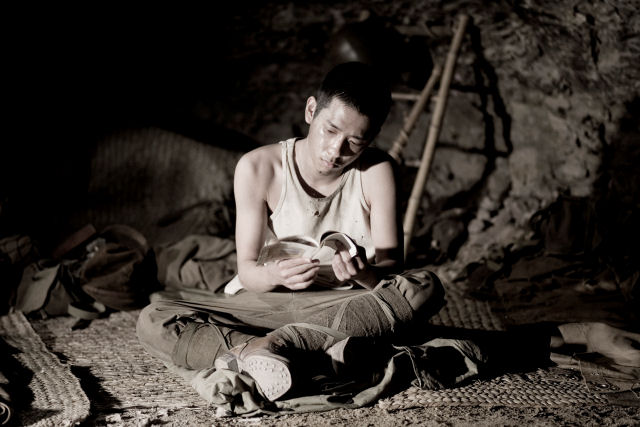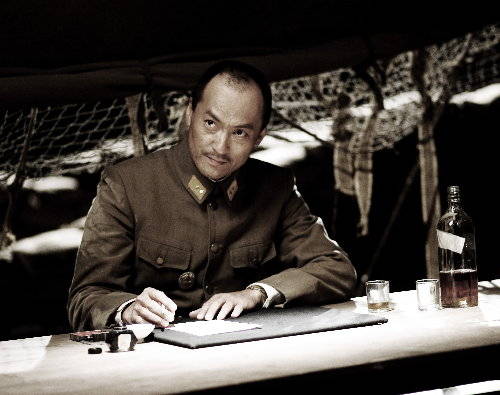“‘Inhumane deeds should be fully acknowledged,’ said Rep. Tom Lantos (D-Calif.), chairman of the House Foreign Affairs Committee…’The world awaits a full reckoning of history from the Japanese government.‘” The House passes a resolution calling for Japan to apologize for its WWII “comfort women” program. [Text.] “Lawmakers want an apology similar to the one the U.S. government gave to Japanese-Americans forced into internment camps during World War II. That apology was approved by Congress and signed into law by President Reagan in 1988.” Well, I’m all for offically recognizing historical sins in the past — *cough* slavery *cough* — but, unfortunately, no mention was made in this bill of our own possible complicity in Imperial Japan’s ugly system of forced prostitution. The resolution might carry more rhetorical force if it did.
Category: Asia
Limited Engagement.
By way of Quiddity and as seen in front of Sunshine, the new trailer for Wes Anderson’s The Darjeeling Limited, with Adrien Brody, Owen Wilson, Jason Schwartzman, and Angelica Houston, is now online. (Hopefully this makes out better than the so-so Life Aquatic.)
Mischa the Bear or Ivan Drago?
“Dmitri Trenin, deputy director of the Carnegie Endowment’s Moscow center, put it well in an insightful article in Foreign Affairs, published a year ago. ‘Until recently,’ he wrote, ‘Russia saw itself as Pluto in the Western solar system, very far from the center but still fundamentally a part of it. Now it has left that orbit entirely. Russia’s leaders have given up on becoming part of the West and have started creating their own Moscow-centered system.'” With Dubya on the road for the G8 summit, Slate‘s Fred Kaplan surveys the state of US-Russian relations, concluding that “something is happening…[but w]e’re not — or at least there’s nothing inevitable about our becoming — enemies.“
Small Comfort, greater shame.
“‘As expected, after it opened it was elbow to elbow,’ the history says. ‘The comfort women…had some resistance to selling themselves to men who just yesterday were the enemy, and because of differences in language and race, there were a great deal of apprehensions at first. But they were paid highly, and they gradually came to accept their work peacefully.‘” The continuing furor in Asia over Japan’s ignominious use of “comfort women” (re: forced prostitution) during WWII reaches America, as it comes to light that occupation Japan created a similar “comfort system” for American GI’s in the year after the war (until MacArthur shut it down in the spring of 1946.) “An Associated Press review of historical documents and records shows American authorities permitted the official brothel system to operate despite internal reports that women were being coerced into prostitution. The Americans also had full knowledge by then of Japan’s atrocious treatment of women in countries across Asia that it conquered during the war…Although there are suspicions, there is not clear evidence non-Japanese comfort women were imported to Japan as part of the program.”
Mother Russia’s Uncle Boris.
In a World of Hurt.
“Writing is a way to have a dialogue with yourself. You can never compete with something in the past, in memory. Like some people said, we love what we can’t have. In this world, the end becomes the beginning. It’s very unfair for anyone around him [Tony] in the present, because they can never compete with his imagination or his memory. We love what we can’t have, and we can’t have what we love.”
Since I spent Friday evening watching In the Mood for Love — a tale of a romance-that-almost-was, told in furtive hallway glances — and 2046 — a broader and more diffuse disquisition on love and heartache — back-to-back, here’s an intriguing 2004 interview with director Wong Kar-Wai on how they fit together: “Mood is a chapter in 2046. It’s like 2046 is a big symphony, and Mood is one of its movements.” Maybe so, but I’m glad I saw them as I did. At first Tony Leung’s Chow in 2046, a dissolute, world-weary rake, seemed eons apart from the quiet, somewhat nervous journalist of ITMFL. But the films are clearly meant to be taken as a piece. From its first images (hole, train) to its last (taxi, hole), 2046 dwells on the corrosive consequences for Chow of ITMFL: The memory of Su (Maggie Cheung), bottled up in the tree, is eating Chow alive…hence, the whole otherwise-non sequitur sci-fi subplot (ITMFL told again, by Chow to himself) involving the indecisive android. (Um, the last few sentences make more sense if you’ve seen the films, but only slightly.)
Now I really kinda wished I’d watched Days of Being Wild, the first part of Wong’s trilogy, before these two. But then again, however sumptuously filmed (these movies are absolutely gorgeous to look at), and however tempered by the presence of several stunningly beautiful actresses (Cheung, Zhang Zi Yi, Gong Li, Faye Wong), there’s only so much exquisite melancholy I can take in a given evening. By the end of this extended tale of romance and loss, I had half a mind to just curl up in a ball and drift amid a sea of despond for the rest of the night, lost in the phantom reverie that was both the allure and prison of “2046” in 2046. Even stronger was the urge to light a cigarette and watch the tendrils of smoke slowly writhe and curl through a shaft of light, preferably to the strands of some vintage Nat King Cole. If nothing else, these very worthwhile films suggest, if you’re going to ruminate on old heartaches, you might as well look really good doing it.
Somebody Set Up Us the Bomb?
In a welcome bit of good news on the international front, negotiators strike a deal in North Korea that lays down a plan for nuclear disarmament by Kim Jong Il’s regime. But all is not rosy yet: “In a harbinger of the potential for difficulties ahead, the official North Korean news agency said the agreement required only a temporary suspension of the country’s nuclear facilities…The agreement also seemed likely to face opposition in Washington by conservatives who remain unconvinced that the North Korean leader, Kim Jong Il, ever intends to relinquish his nuclear weapons. Similarly, the Bush administration faced criticism from Democrats who charge the administration that broke away from the Agreed Framework in 2002 ended up five years later with a roughly similar accord.“
Meanwhile, in related news, a European Union report argues that it is now too late to prevent Iran from developing its own nuclear weaponry. “The admission is a blow to hopes that a deal with Iran can be reached and comes at a sensitive time, when tensions between the US and Tehran are rising. Its implication that sanctions will prove ineffective will also be unwelcome to EU diplomats.”
It Takes an Empire.

[%@*#, that’s aggravating. Movable Type just ate my entire review. Ok, let’s try this again.] A lush, operatic saga of a cancerous ninth-century family fracas that threatens to topple the Tang Dynasty from within, Zhang Yimou’s Curse of the Golden Flower is the type of film for which the cliche “sumptuous visual feast” was coined. True, this sordid tale of betrayal, corruption, incest, and time-release murder is overwrought to the point of self-parody, and the action sequences — like those in Zhang’s House of Flying Daggers — eventually veer well past rousing to the far corner of preposterous. But, my, is this film gorgeous to look at: From start to finish, Curse of the Golden Flower is an explosion of riotous color. (Particularly after sitting through two hours of Letters from Iwo Jima‘s bleak, monochrome grays, viewing the veritable kaleidoscope on display here felt even more sensuous and indulgent.) Throw in some very watchable performances by Chow Yun-Fat, Gong Li, and others, and Curse comes across to me as the best entrant in Zhang’s recent trilogy of fanciful-historical Chinese epics (That would be Curse, Daggers, and the scarily nationalistic Hero — Fortunately the political subtext is more restrained and ambiguous here. In fact, Curse may even be revolutionary, depending on how you read the film’s final image.)
It is the hour of the rat for the Tang Dynasty, chrysanthemums bloom throughout the Middle Kingdom, and opulence comingles with palace intrigue in the halls of the Forbidden City. For the Emperor (Chow Yun-Fat, both fierce and serene), in his Divine wisdom, has seen fit to slowly and secretly poison his Empress (Gong Yi, equally good), by means of a deathly black fungus added to her daily medicine. The Empress, meanwhile, strains to rekindle her romance with the Emperor’s first son (by a previous marriage), the Crown Prince Wan (Liu Ye), but he only has eyes for a fetching maid (Li Man) in the imperial employ. (In fact, she is the daughter of the doctor administering the poison.) And also residing in this increasingly broke down palace are the Princes Jai (Jay Chou) and Yu (Qin Junjie), both of whom discover they have their own roles to play in the schemes of their feuding parents, particularly after the ailing Empress weaves a plot of vengeance to coincide with the coming festival…
Also milling about the Forbidden City is a cast of hundreds: the cooks, maids, laborers, soldiers, ninjas (Yes, this film has ninjas, or at least their Chinese equivalent), and ladies-in-waiting that make up the infrastructure undergirding the Tangs’ divine rule. Zhang goes out of his way here to emphasize the sheer amount of sweat and toil expected of this teeming support staff for even the most mundane task — It takes at least four servants to administer the Queen’s medicine and considerably more to cart the Emperor to and fro. Yet, Zhang seems to suggest, these people are as much part of the story as the resentful royals. They are the props of the extravagant ritual, rigid hierarchy, and striking beauty that characterize the Tang’s rule, and they are ennobled by knowing and playing their appropriate role in this imperial order. Whether or not you agree with this sentiment (and Zhang himself seems to cast doubt on it by the final shot), it does make for several breathtaking scenes of elaborate ceremony throughout the film.
And, yes, some of these are battles. To be honest, both Hero and House probably exhibited better fight choreography. If you come to Curse expecting a martial arts extravaganza akin to those films, you may well leave disappointed. I found the final Helms’ Deepish “silver versus gold” sequence to be too bloodthirsty (beheading prisoners and such), too unrealistic (here, more than anyone else in the film, physics don’t apply) and too obviously CGI for my taste. That being said, there are a few notable melees interspersed throughout the picture, most of them involving the black-clad, scythe-wielding “Flying Monkey”ish ninjas of the Imperial Army, who tend to swoop down from above and bury their scythes in the nearest possible revolutionary with extraordinary aplomb. (Sigh. Only one movie after Iwo Jima, and war and violence are already being made to look artful again.)

Letters Never Sent.
 While I thought most critics lavished too much praise on Pan’s Labyrinth, the very similar swells of appreciation for Clint Eastwood’s Letters from Iwo Jima are, surprisingly, much closer to the mark. Eastwood’s first crack at Iwo Jima in 2006, Flags of our Fathers, was to my mind a well-meaning dog, one made particularly lousy by the heavy-handed fingerprints of Paul Haggis all over the film. But (perhaps due to the different screenwriter, Iris Yamashita), Letters is really something quite remarkable. A mournful, occasionally shocking testament to the inhumanity and absurdities attending war, and a elegiac dirge for those caught in its grip, even on the other side of the conflict, Letters from Iwo Jima is an impressive — even at times breathtaking — siege movie. And strangely enough, elements that seemed trite or intrusive in Flags — the desaturated landscape, the minimalist piano score — are truly haunting and evocative here. In fact, Letters from Iwo Jima is so good it even makes Flags of our Fathers seem like a better movie just by association, which, trust me, is no small feat.
While I thought most critics lavished too much praise on Pan’s Labyrinth, the very similar swells of appreciation for Clint Eastwood’s Letters from Iwo Jima are, surprisingly, much closer to the mark. Eastwood’s first crack at Iwo Jima in 2006, Flags of our Fathers, was to my mind a well-meaning dog, one made particularly lousy by the heavy-handed fingerprints of Paul Haggis all over the film. But (perhaps due to the different screenwriter, Iris Yamashita), Letters is really something quite remarkable. A mournful, occasionally shocking testament to the inhumanity and absurdities attending war, and a elegiac dirge for those caught in its grip, even on the other side of the conflict, Letters from Iwo Jima is an impressive — even at times breathtaking — siege movie. And strangely enough, elements that seemed trite or intrusive in Flags — the desaturated landscape, the minimalist piano score — are truly haunting and evocative here. In fact, Letters from Iwo Jima is so good it even makes Flags of our Fathers seem like a better movie just by association, which, trust me, is no small feat.
 As you probably know by now, Letters from Iwo Jima follows the famous World War II battle, ostensibly depicted in Flags, from the Japanese side. Here, nobody cares about artfully raised flags or the Ballad of Ira Hayes — the emphasis instead is on honor and survival. General Tadamichi Kuribayashi (Ken Watanabe, as captivating here as he was in The Last Samurai) has been ordered to lead the defense of the island against the Americans. To this task, he fully devotes himself, despite fond memories of his earlier days on US soil. But it only takes a few walks around Mt. Suribachi for Kuribayashi to figure out it’s pretty much a no-win scenario — the Americans are too many, too productive, and too strong. And once word leaks out that the Japanese fleet has been broken at Leyte Gulf, Kuribayashi and his men — most notably friendly grunt Saigo (Kazunari Ninomiya), and former Kempetai Shimizu (Ryo Kase) — must slowly come to grips with the fact that they’re not digging cavern defenses so much as their own tomb…a tomb in which many Japanese officers, and not least the headquarters on the homeland, will expect them to die with honor.
As you probably know by now, Letters from Iwo Jima follows the famous World War II battle, ostensibly depicted in Flags, from the Japanese side. Here, nobody cares about artfully raised flags or the Ballad of Ira Hayes — the emphasis instead is on honor and survival. General Tadamichi Kuribayashi (Ken Watanabe, as captivating here as he was in The Last Samurai) has been ordered to lead the defense of the island against the Americans. To this task, he fully devotes himself, despite fond memories of his earlier days on US soil. But it only takes a few walks around Mt. Suribachi for Kuribayashi to figure out it’s pretty much a no-win scenario — the Americans are too many, too productive, and too strong. And once word leaks out that the Japanese fleet has been broken at Leyte Gulf, Kuribayashi and his men — most notably friendly grunt Saigo (Kazunari Ninomiya), and former Kempetai Shimizu (Ryo Kase) — must slowly come to grips with the fact that they’re not digging cavern defenses so much as their own tomb…a tomb in which many Japanese officers, and not least the headquarters on the homeland, will expect them to die with honor.
 What’s particularly surprising here is how unafraid Eastwood is to invert the usual sympathies of a World War II film. It’s not just that the Japanese are the “good guys” here — True, Letters dramatizes the soldiers’ plight by portraying them, particularly Saigo, as just like our fun-loving GI’s at heart. But it also doesn’t shy away from examining a cultural emphasis on dying well that seems completely foreign to the American mind. And, although a wounded American serviceman shows up later in the film, for the most part the US forces are — surprisingly — portrayed here like something out of The Empire Strikes Back, all gleaming, remorseless battleships and Fiery Death from Above. (Some have argued that Eastwood elides over Japanese atrocities in this film, but I’m not sure that’s really fair, unless I somehow just missed the Dresden firebombing subplot in Saving Private Ryan. This is not to say that all war crimes are equivalent or that both sides are equally guilty (although Lord knows it got ugly) — that gets into a moral calculus well outside the bounds of this review — only that Letters seems more interested in portraying war itself as an atrocity, and that enough reference is made to ugly tactics (aiming at medics, for example) that the film doesn’t feel to me like a whitewash.)
What’s particularly surprising here is how unafraid Eastwood is to invert the usual sympathies of a World War II film. It’s not just that the Japanese are the “good guys” here — True, Letters dramatizes the soldiers’ plight by portraying them, particularly Saigo, as just like our fun-loving GI’s at heart. But it also doesn’t shy away from examining a cultural emphasis on dying well that seems completely foreign to the American mind. And, although a wounded American serviceman shows up later in the film, for the most part the US forces are — surprisingly — portrayed here like something out of The Empire Strikes Back, all gleaming, remorseless battleships and Fiery Death from Above. (Some have argued that Eastwood elides over Japanese atrocities in this film, but I’m not sure that’s really fair, unless I somehow just missed the Dresden firebombing subplot in Saving Private Ryan. This is not to say that all war crimes are equivalent or that both sides are equally guilty (although Lord knows it got ugly) — that gets into a moral calculus well outside the bounds of this review — only that Letters seems more interested in portraying war itself as an atrocity, and that enough reference is made to ugly tactics (aiming at medics, for example) that the film doesn’t feel to me like a whitewash.)
The sobering truth at the heart of the grim, moving Letters from Iwo Jima is captured in its penultimate image. (Alas, like too many WWII films, Eastwood opts for an unnecessary contemporary bookend, but it’s not as distracting as the Greatest Generation stuff in Flags. In fact, you might argue that it plays very well off those scenes, in depicting what little survives the war on the Japanese side.) I won’t give it away here…suffice to say that Letters makes clear that War is a demon that rips lives apart and rends men asunder, no matter what side you’re on or for what reasons. Regardless of race, creed, nationality, or ideology, all who invoke its wrath will eventually come to taste tragedy.
Gates, See Clifford.
“It’s not quite clear what George W. Bush wants Robert Gates to do. But it’s doubtful Gates would have come back to Washington, from his pleasant perch as president of Texas A&M, if the job description read ‘staying the course on Iraq.’” Invoking Clark Clifford to make his case, Slate‘s Fred Kaplan suggests what incoming SecDef Robert Gates may be able to accomplish over the next two years.
